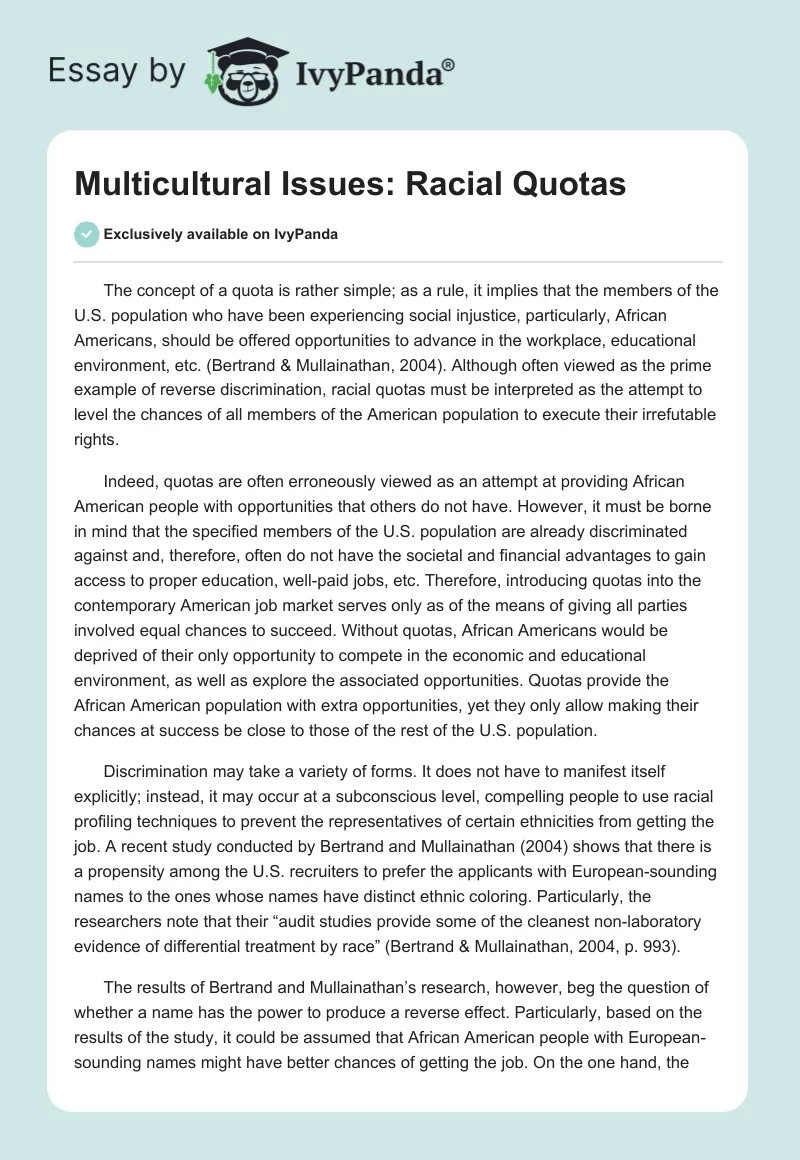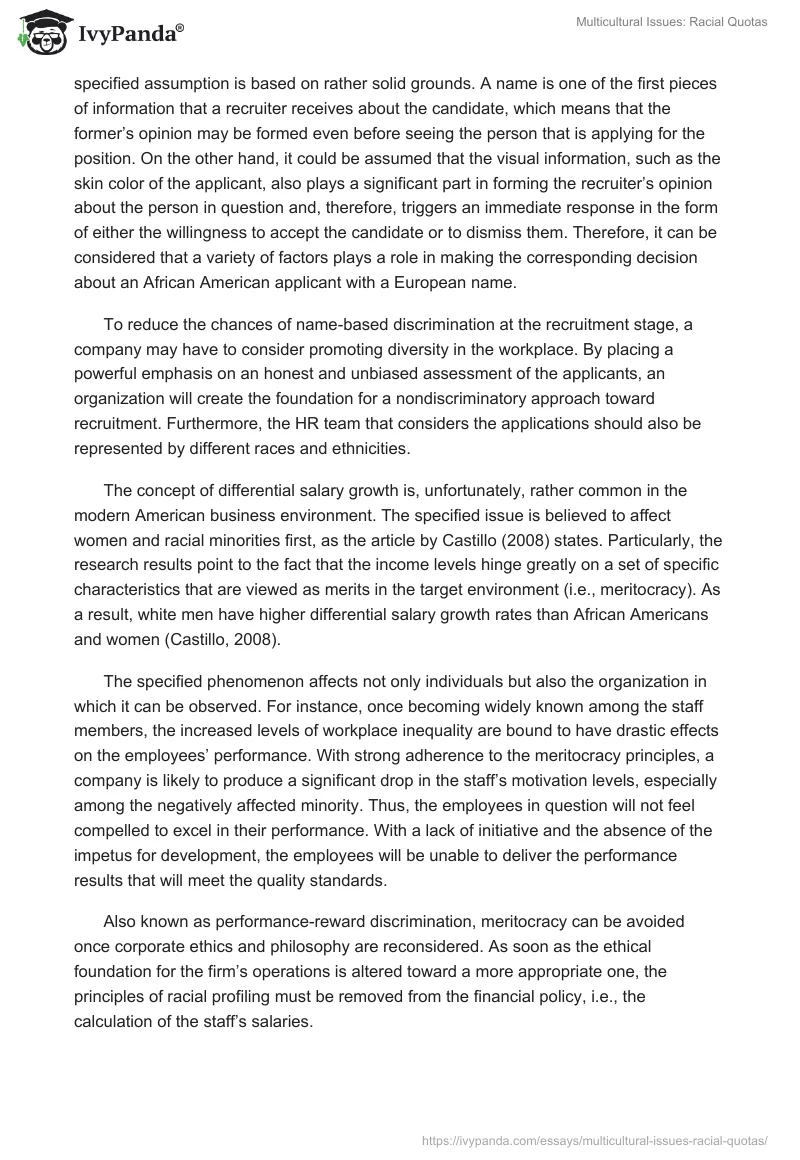The concept of a quota is rather simple; as a rule, it implies that the members of the U.S. population who have been experiencing social injustice, particularly, African Americans, should be offered opportunities to advance in the workplace, educational environment, etc. (Bertrand & Mullainathan, 2004). Although often viewed as the prime example of reverse discrimination, racial quotas must be interpreted as the attempt to level the chances of all members of the American population to execute their irrefutable rights.
Indeed, quotas are often erroneously viewed as an attempt at providing African American people with opportunities that others do not have. However, it must be borne in mind that the specified members of the U.S. population are already discriminated against and, therefore, often do not have the societal and financial advantages to gain access to proper education, well-paid jobs, etc. Therefore, introducing quotas into the contemporary American job market serves only as of the means of giving all parties involved equal chances to succeed. Without quotas, African Americans would be deprived of their only opportunity to compete in the economic and educational environment, as well as explore the associated opportunities. Quotas provide the African American population with extra opportunities, yet they only allow making their chances at success be close to those of the rest of the U.S. population.
Discrimination may take a variety of forms. It does not have to manifest itself explicitly; instead, it may occur at a subconscious level, compelling people to use racial profiling techniques to prevent the representatives of certain ethnicities from getting the job. A recent study conducted by Bertrand and Mullainathan (2004) shows that there is a propensity among the U.S. recruiters to prefer the applicants with European-sounding names to the ones whose names have distinct ethnic coloring. Particularly, the researchers note that their “audit studies provide some of the cleanest non-laboratory evidence of differential treatment by race” (Bertrand & Mullainathan, 2004, p. 993).
The results of Bertrand and Mullainathan’s research, however, beg the question of whether a name has the power to produce a reverse effect. Particularly, based on the results of the study, it could be assumed that African American people with European-sounding names might have better chances of getting the job. On the one hand, the specified assumption is based on rather solid grounds. A name is one of the first pieces of information that a recruiter receives about the candidate, which means that the former’s opinion may be formed even before seeing the person that is applying for the position. On the other hand, it could be assumed that the visual information, such as the skin color of the applicant, also plays a significant part in forming the recruiter’s opinion about the person in question and, therefore, triggers an immediate response in the form of either the willingness to accept the candidate or to dismiss them. Therefore, it can be considered that a variety of factors plays a role in making the corresponding decision about an African American applicant with a European name.
To reduce the chances of name-based discrimination at the recruitment stage, a company may have to consider promoting diversity in the workplace. By placing a powerful emphasis on an honest and unbiased assessment of the applicants, an organization will create the foundation for a nondiscriminatory approach toward recruitment. Furthermore, the HR team that considers the applications should also be represented by different races and ethnicities.
The concept of differential salary growth is, unfortunately, rather common in the modern American business environment. The specified issue is believed to affect women and racial minorities first, as the article by Castillo (2008) states. Particularly, the research results point to the fact that the income levels hinge greatly on a set of specific characteristics that are viewed as merits in the target environment (i.e., meritocracy). As a result, white men have higher differential salary growth rates than African Americans and women (Castillo, 2008).
The specified phenomenon affects not only individuals but also the organization in which it can be observed. For instance, once becoming widely known among the staff members, the increased levels of workplace inequality are bound to have drastic effects on the employees’ performance. With strong adherence to the meritocracy principles, a company is likely to produce a significant drop in the staff’s motivation levels, especially among the negatively affected minority. Thus, the employees in question will not feel compelled to excel in their performance. With a lack of initiative and the absence of the impetus for development, the employees will be unable to deliver the performance results that will meet the quality standards.
Also known as performance-reward discrimination, meritocracy can be avoided once corporate ethics and philosophy are reconsidered. As soon as the ethical foundation for the firm’s operations is altered toward a more appropriate one, the principles of racial profiling must be removed from the financial policy, i.e., the calculation of the staff’s salaries.
References
Bertrand, M., & Mullainathan, S. (2004). Are Emily and Greg more employable than Lakisha and Jamal? A field experiment on labor market discrimination. The American Economic Review, 94(4), 991-1013.
Castillo, E. J. (2008). Gender, race, and meritocracy in organizational careers. AJS, 113(6), 1479-1526.


